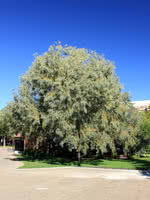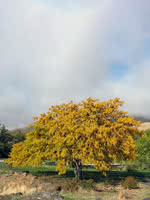Mon-Fri 9am - 5pm Mountain time
Golden Willow vs Thornless Honeylocust
Salix alba vitellina
Gleditsia triacanthos inermis
Golden Willow is an attractive accent tree that's perfectly suited for those moist or wet areas on your property.
This fast growing tree has glossy narrow leaves that turn gold in fall, furrowed brown bark and showy gold branches that especially stand out in the winter.
Golden Willow is commonly used for windbreaks, shelterbelts, and ornamental planting. In addition to looking great, Golden Willow attracts a variety of birds and mammals with its twigs and buds.
All willow are important to native pollinators each spring as they have higher amounts of pollen and nectar early each growing season when other food sources are scarce.
Note: do not plant near buildings or buried services.
Thornless Honey Locust makes an excellent shade tree with its lacy foliage and dappled shade. The leaves are honey-yellow, light and airy, providing interesting color and texture to your landscape. This variety is thornless, and the seeds and pods provide food for wildlife such as deer and squirrels.
The Thornless Honey Locust is tolerant of drought, various soil conditions, and even road salt.
Golden Willow Quick Facts
Thornless Honeylocust Quick Facts
In row spacing: 2.4 - 3 m (8 - 10 ft)

